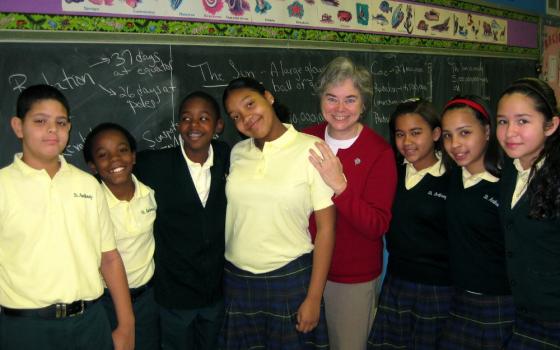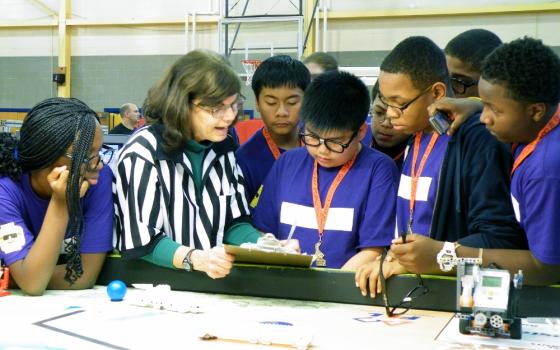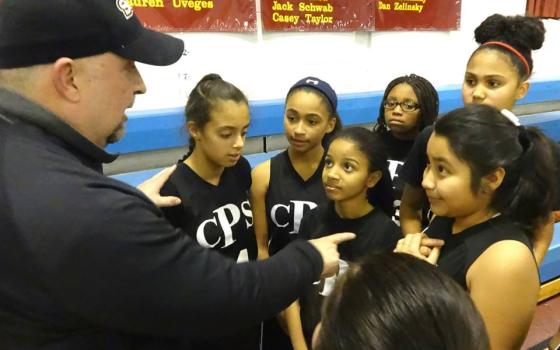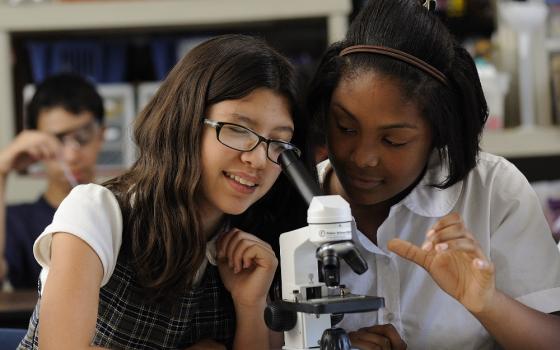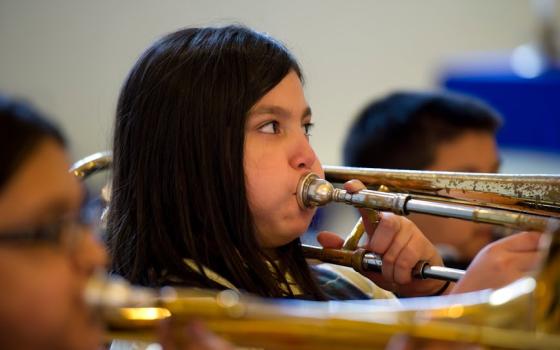As she steers her car towards the intersection of Fifth and York streets in one of the nation’s poorest and most violent cities, Sr. Karen Dietrich points out a house just ahead of us. The home is gutted and charred, the outside adorned with graffiti.
It’s new mayhem, another scar in the North Camden neighborhood that Dietrich knows as executive director of a model effort to sustain quality Catholic education in the urban core. Every day, young students at Holy Name School, one of five Catholic Partnership Schools, navigate its treacherous streets through a moonscape littered with abandoned homes and empty lots.
“Through no fault of their own, our children are growing up with a reality of significant poverty, heart-rending family dysfunction, up-close violence and crime few of us could even begin to imagine,’’ said Dietrich, a Sister of St. Joseph.
“Add to that the challenges of not understanding a language and being caught up in an environment that explicitly detracts from all that builds confidence, self-esteem, pride and academic achievement, and you have the profile of hundreds of our kids. Life is not kind to them.”
Catholic Partnership Schools is a non-profit management organization established in 2009 to operate five Camden schools, kindergarten through eighth grade. Of the 1,000 students, 87 percent qualify for services under Title I, a federal educational initiative for low-income students; 60 percent are Hispanic, 30 percent African-American, 50 percent non-Catholic.
Under Dietrich’s leadership and the collaborative approach she has fostered, enrollment has stabilized, debt has been eliminated, infrastructure needs are being addressed and technology like smart boards (interactive white boards), computer stations and iPads are made equally available to all schools.
Though she and the children are the dynamic faces of the partnership, the management organization owes its inception to the entrepreneurial dedication of Catholic businessman and philanthropist Robert Healey and to his daughter Christine, now chair of the partnership’s board of directors.
Organized after considerable study and consultation with charitable groups and then-Bishop Joseph Galante, the model centralizes operations once duplicated by every school, including development, communications, human resources, academic support and assessment materials. The Diocese of Camden turned over the schools’ operation to the partnership when it formed.
“What is particularly striking about this partnership is that … these schools are built on sound business principles (and) also have strong boards of directors," said Bro. Robert Bimonte, SFC, president of the National Catholic Educational Association.
"They are committed to making a difference in the lives of poor people. I'm grateful for people like Bob Healey and countless others who have joined us in this mission to serve the poor. “
Roughly only 20 percent of the funding for the partnership comes from tuition – the rest is raised by contributions from foundations, corporations and individuals. Currently, the partnership raises about $3.6 to $4 million a year to meet annual operating expenses. For three years the diocese provided funds that largely covered insurance and health benefits, Dietrich said. Now it contributes towards family tuition assistance.
Without formation of the partnership, Dietrich said, three of the five schools would have closed.
“And yet those schools were truly beacons of hope in a city desperate for hope,” she added. “The model created needed to focus, first and foremost, on quality education. The quality would drive the funding, not the other way around.”
You matter
While the heart of the partnership is in the schools, the operational nerve center is found in a third-story suite that once housed government welfare offices. Situated in an unremarkable building blocks from Camden’s City Hall, the small, efficiently designed space is home to the staff that coordinates and manage finances, academics, operations and fundraising.
“It was important from day one, if we brought a donor, journalist or parent, that we didn’t look like we were lavish, but that we paid attention to detail,” Dietrich said. “It says to our children: ‘you matter.’”
Above her desk hangs a framed piece of patterned lace, a reminder, Dietrich explained, of her order’s origin as lace-makers in 17th-century France. Every weekday Dietrich commutes from the northwest area of Philadelphia, where she lives in community with three other Sisters of St. Joseph. Often she will show up after hours to watch an inter-school athletic league game or attend a choir or orchestra concert.
Dietrich spent the first half of her academic career teaching high school biology in New Jersey parochial schools. Just prior to accepting the position of executive director at the partnership, she spent 15 years as principal of Mount St. Joseph Academy, the well-known suburban Philadelphia girl’s preparatory school begun by the sisters in 1858.
Four other Sisters of St. Joseph are part of the partnership staff. They include Sr. Sharon McCarthy, an instructional coach, Sr. Clarisa Vazquez, a family support coordinator, Sr. Alicia Perna, a school principal, and Sr. Rosemary Golden, a fifth grade teacher.
The partnership schools have among the highest proficiency rates in the city and send almost half of their graduates on to Catholic, college-prep high schools. As instructional coach, McCarthy provides support and ideas for teachers. Students’ academic process is measured through an adaptive online test assessment given twice a year, which allows instruction to be shaped to the needs of the individual child. With the help of state and federal grants, all five schools offer free or reduced price breakfast, lunch and afternoon snack.
Despite the challenges presented by buildings of different sizes, ages and conditions, the partnership makes great effort to provide equal access to both materials and enrichment experiences, as visits to three of the schools make clear. These include not only summer and after-school programs but also an athletic league, Partnership choir, orchestra, instrument lessons, robotics and aviation club.
“Catholic Partnership Schools,” said Dietrich, “does everything possible to create a safe and nurturing environment, encouraging our children to reach their fullest potential and fulfilling God’s promise to them of a future full of hope.”
Sharing Resources
Pulling away from the parking lot next to the partnership offices, Dietrich gestures in the direction of Philadelphia, a city that has its own share of educational problems, but resources its poor neighbor city can only dream of.
“Camden is a forgotten city in the shadow of this major one,” she said. “It’s frustrating for me that even though we are three miles from (Philadelphia’s) City Hall, it’s a challenge to draw funders across the river.”
It’s a short drive to Holy Name School, the only one currently not attached to a parish church. On the second and third stories of the corner building, the hallways hum with activity. In the kindergarten room, the walls are crammed with words and letters, a common sight in all five schools. The goal, Dietrich explained, is to provide a “print-rich, word-rich environment” for students who may not be getting that kind of exposure at home. Brightly colored and decorated fishes hang suspended from wires above the small desks.
As in so many of the classrooms throughout the schools, this one has a reading area complete with a rug, cozy chairs and books, in keeping with the emphasis on developing literacy skills among all of their students.
Within the walls of the school there is order and predictability – in part, staff explained, to balance the children’s often stressful life outside. Almost every child at Holy Name has been touched in some way by violence. They may have a parent in prison, are being raised by grandparents, or have witnessed a neighborhood murder.
On the way out of the kindergarten room, Holy Name Principal Patricia Quinter stops for a moment to speak with a boy settling into his seat. Recently, she tells us, the child came home to find his house padlocked because his mother hadn’t met the welfare office requirements for seeking a job. Currently the child is living with his grandfather.
“It’s amazing what these kids have to live with,” said Quinter, who spent decades as a teacher and then a principal in the Philadelphia area before coming to Holy Name.
“We don’t get a lot parent involvement here. Parents struggle, because if they work, they don’t have time to come to come to school and support their children.”
Often, when a holiday looms, students will tell her how much they would rather be in school.
Ten minutes away, in the largely Hispanic Cramer Hill area, St. Anthony of Padua School offers an after-school program that combines English language classes for adult family members with tutoring for students. There is even baby-sitting for their younger siblings. The partnership also sponsors two bilingual family support workers, one of whom follows students through middle school and into high school.
Success within success
Eighth-grader Ashley Melendez will be attending Camden Catholic High School next year – on a scholarship like a lot of her peers. But her time at St. Anthony’s has transformed her into a student leader.
A few years ago, under the leadership of the pastor, Franciscan Fr. Jud Weiksnar, she and some fellow students decided that it was time to make the dark and often dangerous park across from the school grounds a safe place. In addition to organizing clean up days, they were able, through dint of sheer persistence, to win a Camden City Council grant to get lights installed in the park. In their ongoing attempt to make the park a place where children will once again feel safe gathering, they now attend council meetings once a month.
“It’s a family” Melendez said of the school. “I’ve found a voice, found confidence.”
In a trailer next to the school, Claire Geruson, a volunteer with the Sisters of St. Joseph Volunteer Mission Corps, is working with the special needs students.
“It’s been a challenge,” said Geruson, a Boston College graduate who noted that her students have many different learning issues, and that, for seven of the eight, English is a second language.
“It’s a work in progress to figure out how to meet the needs of these individual students. In no way can the work we do be romanticized. There is no part of it that is easy.”
Over at St. Joseph’s Pro-Cathedral, the largest school, physical education and music teacher Barry Moore said he feels like he’s got the best job: working with children of all grade levels.
“You watch them grow more comfortable in their skin, in who they are, and (see their) self-esteem rising,” Moore said, adding that his mission is to let the children know that all things are possible for them.
As a male, African-American teacher, he is conscious of the opportunity to be a role model. Everyone has a dream, he tells the students and “you have to live up to that dream.”
Back at the partnership offices, Dietrich takes a few minutes to reflect on the path that led her to Catholic Partnership Schools, and to work among Camden’s poor. Her early morning “coffee with God” and community prayer and social time with her sisters give her the chance in a very crowded schedule to reconnect and strengthen her relationship with God.
Once Dietrich believed that her calling was to start a high school for disadvantaged students in Philadelphia. But as events unfolded, and the partnership invitation came, “I know I’m in the right place. I don’t have a doubt.”
And while there once were 11 Camden parochial schools between the Ben Franklin and Walt Whitman bridges that link New Jersey and Pennsylvania, the five that remain are carrying a tradition forward.
“Catholic schools in the inner city have always been a source of hope as well as a pathway out of poverty,” said Bimonte, of the National Catholic Educational Association.
“The Catholic schools in the heart of Camden supply a place of stability for everyone in the neighborhood. These schools are safe havens where students don’t have to be afraid (and can) learn. That’s the miracle.”
[Elizabeth Eisenstadt Evans is a religion columnist for Lancaster Newspapers, Inc., as well as a freelance writer.]
